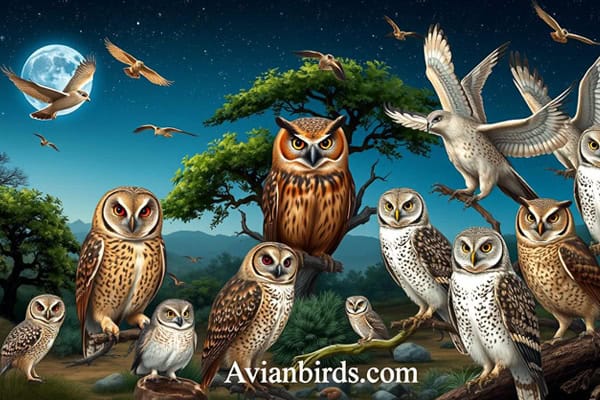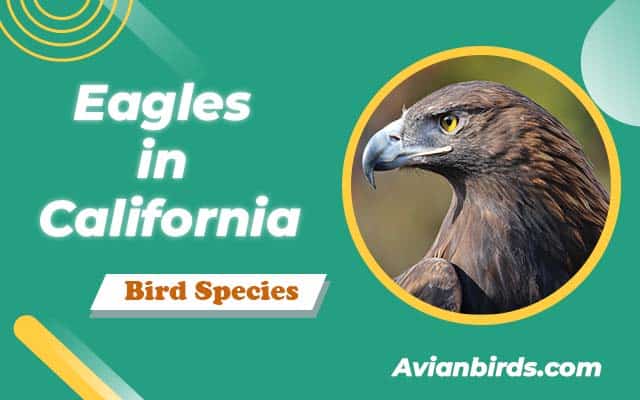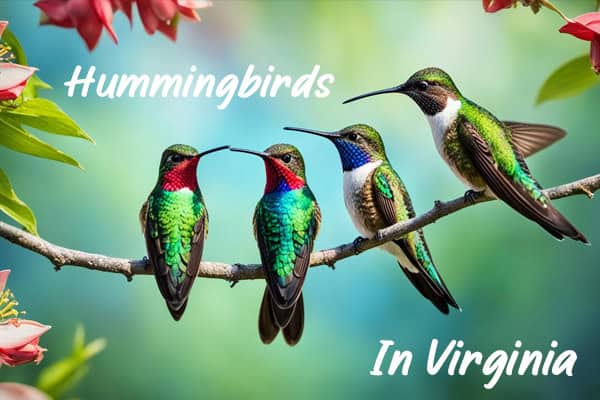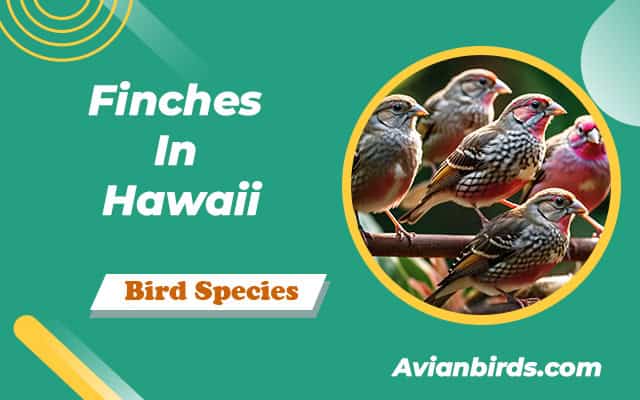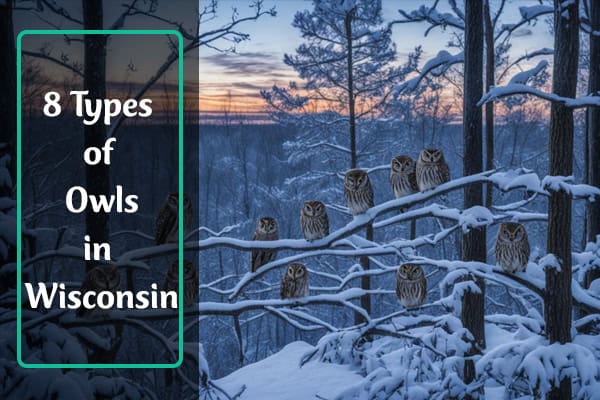12 Types of Owls in Africa (ID Guide With Pictures)
Do you know Africa is home to over 12 different types of owls? Each has special features to live in different places. They are amazing, from the tiny Pearl-spotted Owlet to the big Verreaux’s Eagle Owl.
This guide will take you into the world of African owls. You’ll learn how to tell them apart and about the different types. You’ll also see beautiful pictures of owls.
This guide is perfect for bird lovers or anyone new to owls. It will help you understand and enjoy these amazing birds in their homes.
Introduction to African Owls
African owls are fascinating and diverse, with about 50 species. They live in different places, like savannas and woodlands. This makes them perfect for hunting at night.
Eleven owl species are found in Africa. Each has special ways to survive.
Owls are important in their homes. They keep rodent and insect numbers down, keeping their places healthy.
Their night vision and hearing are amazing. These help them live well in their homes.
The African Scops Owl is small, about six inches. The Pel’s Fishing Owl is big, up to two feet tall. Sadly, some owls are in danger because of lost homes and pollution.
The Seychelles Scops Owl is almost gone, with less than 300 left. We need to save them and their homes.
Learning about these owls shows why we must protect them. We want African owls to keep flying over this lively continent.
The Unique Characteristics of Owls
Owls are special in the bird world. They have owl characteristics that help them survive and hunt. Their facial disk collects sound, making their hearing exceptional.
These birds can fly silently. Their feathers have edges that reduce noise, allowing them to sneak up on prey at night.
Owls also have amazing eyesight. They can see much better in the dark than humans, making them great hunters at night.
Owls hunt in different ways. They can sit still, chase prey, or attack from hiding. Their special features help them adapt to many places around the world.
Major Habitats of Owls in Africa
African owls live in many different places. They can be found in woodlands, grasslands, savannas, wetlands, and even cities. Each place has its own challenges and chances for owls to thrive.
The African Grass Owl loves moist grasslands and wetlands in sub-equatorial Africa. It lives high up, between 0 to 3200 meters, in mountains like the Cameroon Mountains. It hides well in tall grass near water, hunting small rodents and shrews.
The Spotted eagle owl lives in southern Africa’s open scrub, grasslands, and woodlands. Its big wingspan, almost one meter, helps it move around easily. The owl eats insects and small mammals, finding food in different places.
Knowing where owls live in Africa helps us understand their role in nature. African grass owls keep small mammal numbers in check, and Spotted Eagle Owls help balance ecosystems. Saving their homes is key to keeping these owls around.
1. African Grass Owl
The African Grass Owl, known as Tyto capensis, has unique features. It has a heart-shaped face and a yellow neck with dark spots. Adults are 15 to 17 inches tall and have a 13.6-inch wingspan.

Physical Description
This owl’s upperparts are darker when it flies. It needs thick grass for roosting or nesting. Its color and size help identify it, especially in South Africa’s wet areas.
Behavior and Habits
African Grass Owls are hard to spot because they hunt at night. Also, They make tunnels in the grass for nesting. They hunt rodents, shrews, birds, and insects, especially vlei rats.
They are quiet hunters. This makes them interesting to watch, especially in low-lying areas and near cities.
2. Barn Owl
The Barn Owl, known as Tyto alba, is quite unique. It has a white, heart-shaped face and brown edges. It’s about 17.3 inches tall and has a wingspan of 35 to 50 inches. People call them “ghost owls” because of their striking looks.
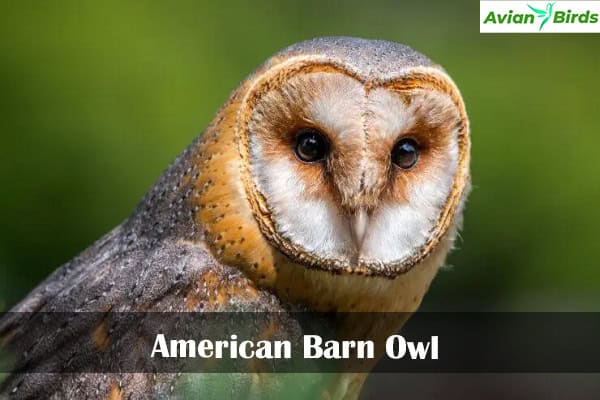
Distinctive Features
The Barn Owl’s features are truly special. Its feathers help it blend in well in its favorite places. These include:
- Hollow trees
- Caves
- Abandoned buildings
This owl is not just beautiful but also great at hunting. It can eat up to 10 mice in one night. Its calls are haunting and very interesting.
Habitat and Range
The Barn Owl lives in many places but loves open areas like grasslands and farmlands. It can live in both rural and city areas. In the right place, it can live a long time, even in captivity.
Learning about the Barn Owl is important for bird lovers and for helping the environment. It helps keep mouse numbers down. By protecting its habitat, we help it and other amazing African owls.
3. African Scops Owl
The African Scops Owl, or Otus senegalensis, is found all over Africa. It lives in many places, like wooded savannahs and gardens. Knowing how to spot this owl is key for bird lovers.
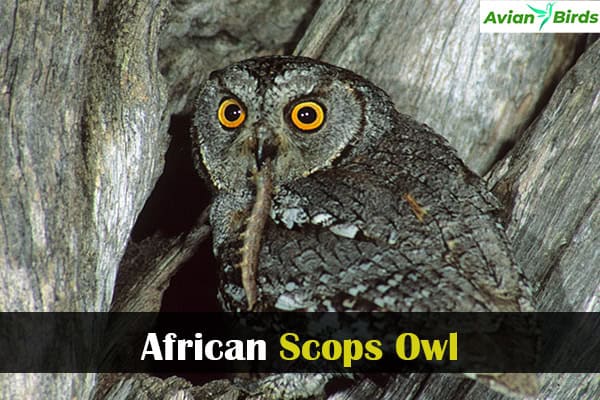
Identification Tips
Here’s how to tell the African Scops Owl apart:
- It’s small, about 6.7 inches tall.
- It has gray facial disks with narrow black borders.
- Its ear tufts are shorter than others.
- Look for its unique, irregular patterns.
- Its bright yellow eyes are very noticeable.
Learning these tips will make watching owls more fun. You’ll appreciate the African Scops Owl even more.
Diet and Feeding
The African Scops Owl eats big insects and small animals. It hunts from high up, then swoops down to catch its prey. It nests in tree holes, keeping its young safe.
Watching how it hunts shows its important role in nature. It’s a fascinating part of Africa’s wildlife.
4. Southern White-faced Owl
The Southern White-faced Owl, known as Ptilopsis granti, is a bird with a unique look. It has a white face with black edges and bright orange eyes. Adults are 20 to 24 centimeters long and weigh 185 to 275 grams. Females are usually bigger than males.

This owl lives in savannas, woodlands, and river forests. It can live in many places, from Uganda and Kenya to South Africa. It likes to hunt near streetlights and grass fires.
The owl eats big insects and small mammals, which comprise most of its diet. It uses clever ways to catch its food. When scared, it can puff up or slim down to avoid predators.
In the summer, females lay 2 to 4 eggs in other birds’ nests. The eggs hatch in January to May. In the wild, they can live up to 30 years. However, pesticides and losing their homes threaten them. Luckily, they are not in danger of disappearing.
5. Cape Eagle Owl
The Cape Eagle Owl, known as Bubo capensis, is a stunning bird. It has a brown and white face and interesting social ways. It’s 18 to 24 inches long and found in mountains from Ethiopia to South Africa and Namibia. It’s not in Botswana.
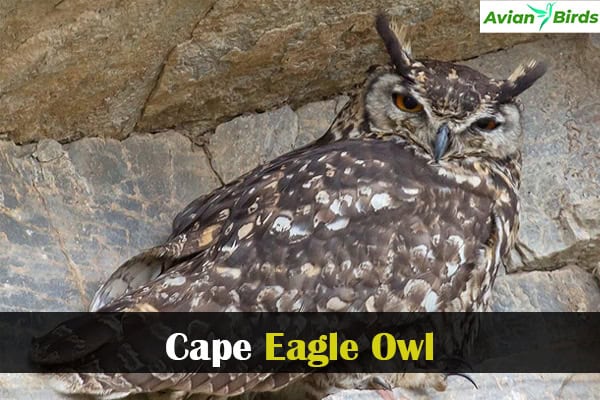
Moreover, It’s not really worried about it, but we still watch it. This is because it plays a special role in its environment.
Identifying Characteristics
Here’s what makes the Cape Eagle Owl special:
- Weight: Males are 905 to 1,387 grams, females 1,240 to 1,800 grams.
- Wing length is 34.3 to 41.8 cm, tail 15.5 to 26.6 cm.
- There are three subspecies: Bubo capensis, Bubo mackinderi, and Bubo c. dilloni.
- They like a 2.5 km² territory, showing they like their homes.
Social Behavior
The Cape Eagle Owl’s social life is interesting. Pairs stay together, which helps them raise their young. They breed from May to July in Zimbabwe and northeastern South Africa. In the southwestern Cape, it’s from June to September.
The female lays eggs for 34 to 38 days. After hatching, the young ones need their parents for 2 to 3 months. This shows strong family ties. The way male and female owls talk to each other is unique during these times.
6. Spotted Eagle Owl
The Spotted Eagle Owl, known as Bubo africanus, is very interesting. It has striking looks and behaviors. It lives in both cities and the countryside.
Knowing where it likes to live and what it eats helps us understand it better. This owl can live in many places.

Habitat Preferences
The Spotted Eagle Owl lives in southern Africa. It likes different places to live. These include:
- Rocky regions
- Woodlands
- Urban areas
- Forested areas
This owl is good at living near people. It uses buildings and trees for homes. It likes open places for hunting.
Feeding Habits
The Spotted Eagle Owl eats many things. Its diet includes:
- Rodents
- Small mammals
- Birds
- Insects
- Reptiles
This owl is very good at hunting. It hunts at night with its sharp eyes. After eating, it throws up what it can’t digest. This shows what it ate.
| Characteristic | Details |
|---|---|
| Scientific Name | Bubo africanus |
| Length | 45 cm (18 in) |
| Weight | 454 to 907 grams (1.0 to 2.0 lb) |
| Wingspan | 100 to 140 cm (39 to 55 in) |
| Diet | Rodents, small mammals, birds, insects, reptiles |
| Lifespan | 10 years in the wild, up to 20 years in captivity |
| IUCN Status | Least Concern |
7. Verreaux’s Eagle Owl
The Verreaux’s Eagle Owl, known as Bubo lacteus, is one of Africa’s largest owls. It can grow up to 26 inches long and has a wingspan of up to 1.8 meters. Its gray facial disk and bright pink eyelids make it stand out. It can hide well in its surroundings.

Distinctive Features
Females of this owl can weigh up to 3 kg, making it the fourth heaviest owl in the world. It is similar in size to some Eurasian eagle-owls but smaller than most. It lives in forests, savannas, and bushlands across sub-Saharan Africa.
Vocalizations and Communication
The Verreaux’s Eagle Owl uses its calls for communication and to mark its territory. It eats small to medium-sized animals. During breeding, it uses calls to talk to its mate.
Breeding pairs are very protective of their territory. They communicate well with each other and their young. Interestingly, only one chick usually survives, relying on its parents for food and protection.
Must Read: Owls In Arizona
8. Pearl-spotted Owlet
The Pearl-spotted Owlet, known as Glaucidium perlatum, is Africa’s smallest owl. It’s 6.6 to 8.3 inches long. Its spots and yellow eyes make it easy to spot.
Knowing its looks and habits can make birdwatching better.
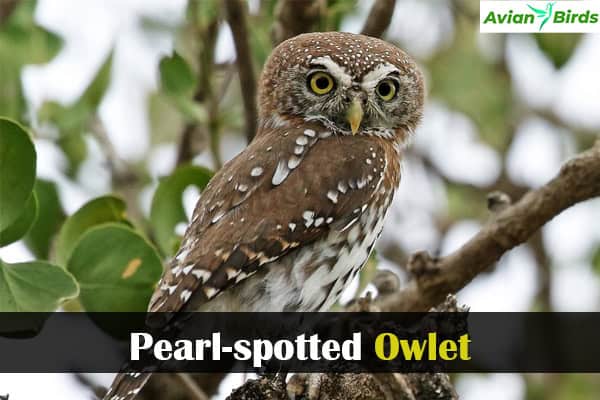
Identification Features
The Pearl-spotted Owlet stands out because of:
- Size: It’s 17 to 21 cm long with a wingspan of 100-118 mm
- Coloration: It has brownish-grey feathers with white spots
- Facial Disk: It has a big facial disc and bright yellow eyes
- Tail: Its tail is short with special markings
- Sexual Dimorphism: Females are bigger, weighing about 100g, while males weigh 65g
This owl lives from southern Mauritania to Ethiopia and down to northern South Africa. It likes open savannas and semi-open woodlands.
Must read: Owls That Live in Indiana
Behavioral Traits
The Pearl-spotted Owlet’s behaviors are as interesting as its looks. It’s known for:
- Hunting Strategies: It mainly eats arthropods, rodents, bats, lizards, snakes, and small birds. Its quick hunting skills help it catch prey well.
- Vocalizations: It makes different calls at night. These calls help it talk to other owlets.
- Nesting: It lays 2 to 4 white eggs at a time. The eggs hatch after about 29 days. The young owlets leave the nest at about 31 days old.
- Predation Awareness: Even though they hunt during the day, they must watch out for bigger predators like the Red colobus.
Owls of Africa: Ecological Importance
Owls are key in Africa’s diverse ecosystems. They keep small mammals and insects in check. This balance keeps their habitats healthy and diverse.
Owls are more than just predators. They show us how healthy the environment is. They are very sensitive to changes in their habitats and pollution.
In Africa, owls play a big role in the food web. For example, the Verreaux’s Eagle-owl eats a lot of different things. This helps keep the ecosystem balanced.
Owls help keep the ecosystem in balance. They are important for biodiversity. Their presence is crucial for a healthy environment.
There are many owl species in Africa, but some are facing threats like habitat loss. Protecting these birds is important for the ecosystem’s health.
| Owl Species | Key Ecological Role | Threats |
|---|---|---|
| Verreaux’s Eagle-owl | Controls small mammal and bird populations | Habitat loss, human persecution |
| African Wood-owl | Maintains balance in rodent and insect numbers | Habitat destruction, pesticide exposure |
| Shelley’s Eagle Owl | Indicators of Rainforest Health | Vulnerability and habitat fragmentation |
Threats to Owl Populations in Africa
Owls in Africa face many challenges. Habitat loss is a big problem. This happens because of deforestation, farming, and the growth of cities.
These changes hurt the homes of owls. This leads to fewer owls in many places.
Another problem is running into power lines and cars. Climate change also makes it harder for owls to find food and places to live. For example, the Grass Owl and Pel’s Fishing Owl are in trouble.
They need open lands and clean rivers to survive. But these places are getting less safe for them.
In South Africa, some people think owls are bad luck, which can cause them to get hurt or killed. Talking to communities about their beliefs might help protect owls.
Even rare owls like the Itombwe owl, which lives in the Itombwe Nature Reserve in the Democratic Republic of Congo, are at risk. The last time anyone saw it was in 1996.
This reserve is very important for many animals. But only a few thousand Itombwe owls are left, and it is very important to save them.
To help African owls, we need to listen to local people. Knowing their stories and ways of life can help us protect these amazing birds.
Also, visit: Owls in Arkansas
Conservation Efforts for African Owls
Protecting owls in Africa is very important. Many species are threatened by lost habitats and human actions. Groups working to save African owls have made big efforts.
The Owl Rescue Centre helps about 2,000 owls each year. They focus on getting these birds back to where they belong. The center is huge, covering 12,000 hectares, to keep humans away and help owls heal.
In Mpumalanga’s Highveld, people are working hard to save Grass Owls. They have watched and protected these birds for years. Their work has paid off, with more Grass Owls being born.
But these owls still face big problems. Pollution and changes in their homes from farming and mining are big threats.
The Dominican Republic Owl Conservation Project is another example. It focuses on local owl species and teaches kids about conservation, helping to build a future where owls can live safely.
Overall, groups are doing a lot to save owls now and in the future. They show us how we can help too. We can support local projects or tell others why saving owls is important.
Best Locations for Owl Watching in Africa

Watching owls in Africa is an amazing experience. It’s especially great in places known for their wildlife. Many owl-watching spots let you see these birds in their homes.
The Kruger National Park is a top spot. It has 11 out of 12 owl species found in Southern Africa. You can see cool birds like the Verreaux’s Eagle Owl and the common Pearl-spotted Owlet. The African Marsh Owl is harder to find but shows up more in wet seasons.
- Okavango Delta, Botswana: This place is known for seeing the rare Pel’s Fishing Owl.
- Etosha National Park, Namibia: The Verreaux’s Eagle Owl and Pearl-spotted Owlet are often here.
- Kgalagadi Transfrontier Park: Located between South Africa and Botswana, it’s great for owl-watching because of its different habitats.
- Selous Game Reserve, Tanzania: This big reserve is perfect for bird watching with its waterways and lagoons.
For a great owl-watching trip, think about a 12- to 15-day birding tour. This lets you see all twelve southern African owl species. You can also pick a tour that fits your interests, making your trip even better. Summer in South Africa is the best time to see both local and traveling owls.
Working with local guides can really help you see more owls. Enjoy the beauty of Africa as you search for these amazing night birds.
Must Visit: Owls in Massachusetts
Conclusion
African owls are a fascinating part of the continent’s wildlife. But, they face many dangers that threaten their survival. Over 333 owls have been killed in Africa for reasons like superstitions and traditional medicine.
This shows we need to act fast to save them. Owls are important because they help keep ecosystems balanced. They control the numbers of small mammals and insects.
There are efforts to protect these amazing birds and their homes. In East Africa, people are working together through science and education. By learning about owls, we can help save them.
Your help in protecting owls is crucial. It will ensure that future generations can enjoy these birds. Saving owls is key to our planet’s health and our natural treasures.
Read More🐦Related Articles:
| Hummingbirds in Texas |
| How to Keep Squirrels Out of Bird Feeders |
| Woodpeckers Found in Oregon |
| Woodpeckers in Indiana |
| Woodpeckers in Arizona |
Frequently Asked Questions
Q1. Does Africa have owls?
Yes, Africa is home to a variety of owl species.
Q2. What is the myth about owls in Africa?
In some African cultures, owls are often associated with death or bad omens.
Q3. What is the largest owl in Africa?
The African Spotted Owl is one of the largest species found on the continent.
Q4. What is the big owl in South Africa?
The Verreaux’s Eagle-Owl is the largest owl found in South Africa.

